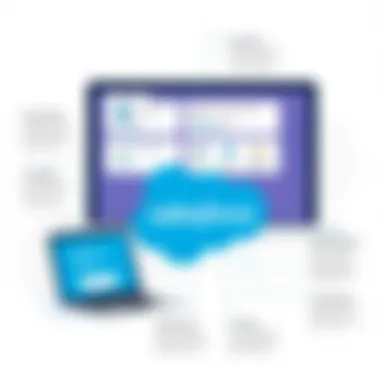Exploring Salesforce as an Innovative Student Information System


Overview of Topic
Salesforce has taken the educational landscape by storm, transforming how institutions approach data management and communication. Understanding its role as a student information system is crucial for educators, administrators, and IT professionals alike. The significance of this topic can't be overstated – as schools, colleges, and universities increasingly turn to technology to streamline their operations, Salesforce presents a promising solution.
Historically, student information systems (SIS) were primarily focused on record-keeping. However, with the evolution of cloud computing and technology, the scope of SIS has broadened. Salesforce began its journey as a customer relationship management platform, but its adaptability has allowed it to evolve into a versatile tool in many sectors, including education. This adoption marks a shift in how institutions interact with their students, moving from traditional paradigms to dynamic, data-driven approaches.


Fundamentals Explained
At its core, the capabilities of Salesforce as a student information system lie in its ability to facilitate data management and improve communication. Here are essential concepts:
- Student Profiles: Each student can have a detailed profile that tracks their academic journey, personal information, and extracurricular activities.
- Data Analytics: Salesforce offers powerful analytics tools that allow institutions to glean insights from vast amounts of data, enabling informed decisions.
- Integration: The ability to integrate with other tools and platforms enhances the functionality of Salesforce, allowing seamless data flow across systems.
Key terminology includes:


- CRM (Customer Relationship Management): Refers to technology for managing relationships and interactions with customers; in education, that translates to relationships with students and their families.
- Dashboard: Visual representation of data, making it easier to interpret student metrics and trends.
Overall, a firm grasp of these fundamentals sets the stage for understanding how Salesforce functions in educational settings.
Practical Applications and Examples


Consider the case of Greenwood College, which adopted Salesforce to manage student information effectively. The institution utilized the platform to create a centralized database where they could monitor student performance and streamline administrative tasks. This system played a pivotal role during the admissions process, allowing seamless communication between departments.
From a practical standpoint, institutions can implement Salesforce in numerous ways:
- Tracking Student Progress: Courses and grades can be updated in real-time, giving educators immediate access to performance data.
- Communication Tools: Built-in tools can enhance communication channels between administration, faculty, and students.
- Reporting Capabilities: Generating reports based on various metrics can assist in identifying areas for growth and development.
A hands-on project might involve setting up a basic dashboard within Salesforce to monitor student attendance and academic performance across several classes.
Sample Dashboard Elements
- Student Name
- Attendance Rate
- Average Grade
- Engagement Levels







